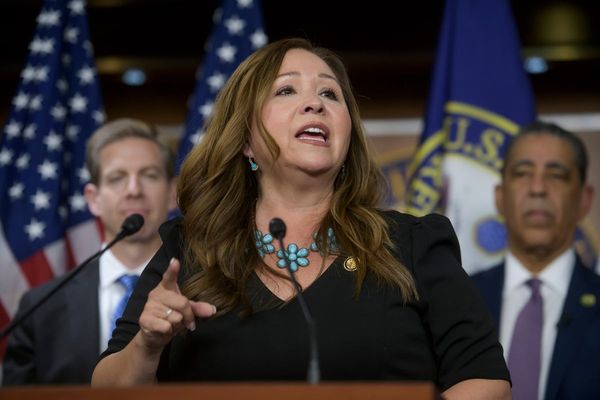
Over the course of Friday at the MotoGP German Grand Prix, it became increasingly clear that Jorge Martin’s contractual standoff with Aprilia was now over. The world champion will fulfil his two-year deal by remaining at the team for 2026.
But what was it that ended a deadlock which began at the French Grand Prix back in May, shortly after which Autosport broke the story to the world?
In the end it was the intervention of Dorna CEO Carmelo Ezpeleta at Assen that buried Martin’s hopes of being released from his Aprilia contract to sign with Honda for next season.
The stalemate between the Spanish champion and the Italian manufacturer effectively ended at Assen, precisely at the moment when Ezpeleta warned that neither Dorna nor IRTA – the Teams’ Association – would register any rider with an unresolved conflict with a team or manufacturer.
“We will not accept the registration in the world championship of any rider who is not free, either through a judge’s ruling or through having reached an agreement with the other party,” said Ezpeleta.
These words from the top executive in the championship nullified the strategy of the rider and his agent, Albert Valera. At the same time, they supported Aprilia’s stance that the contract’s release clause was invalid due to Martin’s long-term injury.

After a few days of reflection and ahead of his expected return to racing next week at Brno, the Madrid-born rider has decided to forgo what he considers his contractual right and instead focus on racing, continuing with Aprilia in 2026, as reported by Diario AS.
To understand everything that has led Martin to this point, we must go back to the Saturday of the 2024 Italian Grand Prix last June. That day, Valera realised that Ducati would not follow through on a verbal agreement made the week before to promote Martin to its factory team. The Borgo Panigale manufacturer instead chose Marc Marquez, informing Martin on the Sunday night that he had gone from selected to rejected.
After this disappointment, Valera reached out to Honda, which had already shown interest in Martin weeks earlier and now reaffirmed its commitment to signing him. At the same time, Aleix Espargaro – then still Aprilia’s ‘Capitano’ – stepped in. The Catalan rider spoke to Aprilia CEO Massimo Rivola and encouraged him to act quickly with an offer.
An agreement was drafted overnight and signed on the Monday morning. Valera informed Martin of Honda’s offer, which was significantly more lucrative, but the rider believed the Tokyo bike was not on a par with the RS-GP. Even so, to cover his bases, Martin had a clause added to the contract that would, in theory, provide him with an escape route for 2026.
Activating that clause seemed simple: if after the first six races of the season he was not among the top five in the standings, he would be free to sign with Honda – and only Honda.
One week before the deadline, which coincided with the French Grand Prix, Aprilia informed Martin that it considered the clause invalid since his injury had kept him from participating in any races up to that point. Martin secretly travelled to Le Mans to notify Aprilia that he was activating the clause nonetheless. He also met with Ezpeleta, who even then made it clear he would not accept the move and that Martin had to stick to the two-year deal he had signed.

All parties involved tried to keep the dispute confidential. But when Autosport broke the story, tensions between Martin and the team skyrocketed.
Just 10 days later, ahead of the British Grand Prix, Aprilia broke its silence with a brief statement: “Aprilia Racing denies that any negotiations have taken place between the parties to modify the duration of the contract, which remains as originally agreed upon. The team has no comment on matters that do not directly concern it but expects other teams to refrain from making any kind of offer to riders who are under contract. Such behaviour would, in any case, not be legitimate.”
This statement was clearly directed at Honda, which Rivola had already privately warned at Le Mans.
When the contract was drafted, Martin’s lawyers attempted to ensure that any legal disputes would be settled by the Court of Arbitration for Sport (CAS), but Aprilia insisted that they be handled in the courts of Milan.
With the Martin camp feeling cornered, Valera tried to stir the pot at Assen, in a gesture intended for Honda. During a live MotoGP broadcast he said: “Jorge Martin is free to sign with whoever he wants for 2026.”
However, that move triggered Ezpeleta’s decisive response, reinforcing Aprilia’s position and its refusal to negotiate any kind of release. Valera even proposed a buyout, but the amount Aprilia demanded was utterly unfeasible. From that point forward, the escape plan was completely shut down, and Martin accepted that he would not wear HRC leathers before 2027.

Aprilia’s stance, fully backed by parent company the Piaggio Group, was to remain firm at every step. At the same time, the team consistently expressed its intent to win over the current champion with a MotoGP project that has progressed substantially since the start of the year, with Marco Bezzecchi winning the British Grand Prix.
That approach was evident during Wednesday’s test day at Misano, when Martin returned to riding for the first time since he was injured in Qatar. The test was attended by the team’s top brass, which reiterated its conciliatory approach on Friday at the Sachsenring.
Almost two months to the day since the story broke, the final outcome is that Martin has decided to surrender. He will race with Aprilia until the end of 2026, aiming to maintain his status as a top contender in the championship.
After that, he can freely decide his future – which, for now, looks unlikely to involve Aprilia. Time will tell whether Honda is still interested in Martin for 2027.







